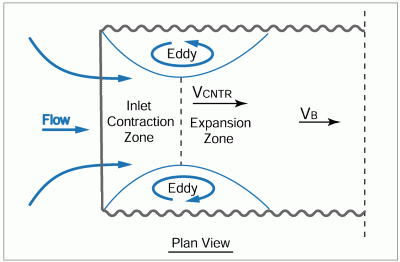Inlet Contraction Velocity |

Illustration of inlet zone hydraulics, adapted from Behlke et, al. 1992.
The hydraulic environment within the inlet zone of a culvert is typically classified as rapidly varying flow. Two distinct sections exist within the inlet zone: a contraction zone where streamlines contract as the water enters the culvert and an expansion zone that exists immediately downstream of the contraction. This contraction occurs as water from the upstream channel enters into the culvert inlet. If the culvert is narrower than the channel the abrupt change in width causes flows to be constricted.
Head loss occurs as water passes through the inlet zone. The magnitude of the head-loss is dependent on the velocity within the culvert barrel and inlet geometry, which determines the appropriate entrance loss coefficient. The head-loss coefficient is a function of transition efficiency as the water enters the culvert from the upstream channel.
As the water enters the culvert, velocities increase until they reach the point of maximum contraction. In this zone there is a drop in the hydraulic grade line, which is evident by a drop in water surface. At the same time there is an increase in kinetic energy that is equal to the drop in the hydraulic grade line minus frictional losses. Just downstream of the contraction is an area of rapidly expanding flow. A large portion of the entrance headloss occurs within the expansion
The contraction zone at a culvert inlet can hinder fish passage due to the increased velocities and steeper water slope. FishXing approximates the maximum contraction velocity by assuming the calculated entrance headloss through the inlet zone is first converted entirely to kinetic energy, and that this gained kinetic energy is then lost in the expansion.
FishXing uses the following equation to calculate the contraction velocity, and reports it as the velocity immediately inside the culvert in the Water Surface Profile Results:

Where:
Vcntr = Contraction velocity
Ke = Entrance loss coefficient
VB = Average cross sectional water velocity within the culvert barrel, located at the point where the velocity contraction occurs.
For this application the Barrel Velocity (VB) is the average cross-sectional velocity at the location of the contraction, calculated assuming gradually varied flow conditions. For calculations, the location of the contraction is defined as 2 feet (0.61 m) from the inlet for culverts 9 feet wide (2.75 m) or smaller and 3 feet (0.91 m) from the inlet for culverts larger than 9 feet (2.75 m) (Behlke, 1992). FishXing assumes the approach velocity is zero just upstream of the inlet.
See also: